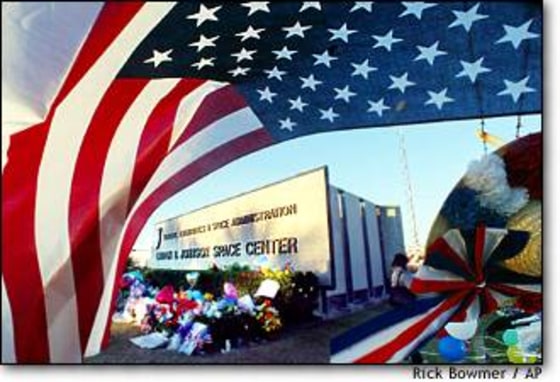I’m walking toward Building 2 at NASA’s Johnson Space Center, surveying the phalanx of satellite TV trucks surrounding the place, a reminder that if the United States had never had a space program, there wouldn’t be any satellite TV transmissions from anywhere. Building 2 houses a large auditorium where NASA conducts press briefings during major events, and because of the Columbia disaster, we media people are here by the hundreds.
I first came to Johnson Space Center 30 years ago as a young NBC correspondent assigned to cover the SkyLab and Apollo-Soyuz space missions. My wife and I bought our first home just a couple of miles down the road from the space center. We quickly learned that this is a tightly knit community where most people either work for NASA or its aerospace contractors or live next door to someone who does. It’s the sort of place where most people follow every space mission closely, liftoff to landing. In some local restaurants here, the walls are full of autographed pictures of astronauts.
Houston's grief
“The whole Houston area is grieving,” says Lois Merilatt, a patron at Miller’s Cafi, a local hangout, “NASA is a big part of this community.”
“It’s like a death in the family,” says the Rev. Steve Riggle of the Grace Community Church in nearby Clear Lake. Rev. Riggle wears a shuttle pin in the lapel of his jacket. This is a church in mourning for two of its members, Shuttle Commander Rick Husband and payload specialist Michael Anderson.
“They always were positive and optimistic,” says Rosemarie Shellshear, a member of the congregation, “Of course, they knew there was danger but they always looked on the bright side.”
Eleven days before the Columbia’s Jan. 16 launch, Husband and Anderson spoke at Sunday services, appearing with their families, asking church members to pray for the safety of the shuttle crew.
Space program's ground zero
If there’s one key place where people come to share their grief, it’s the front gate at Johnson space center. Here, they’ve placed flowers, balloons, stuffed animals and posters expressing their sorrow and their support for the families of the seven Columbia astronauts.
We’ve seen this kind of thing before — at Ground Zero in New York, at Columbine High School, at the site of the Oklahoma City bombing and at other scenes of overwhelming tragedy.
Huge crowds of people come here with their children. Families try to find a way to express their sympathy, to come to grips with this disaster.
A man points at a picture of the seven astronauts who were lost aboard Columbia. “That’s my son on the lower right,” he tells a group of children, “They were all heroes.”
The man is Barry McCool, the father of astronaut William McCool, Columbia’s pilot. Barry, a former U.S. Navy pilot, is here with his wife, Audrey, to observe the public outpouring of sympathy for their son and for the six other shuttle astronauts. He has tears in his eyes, his demeanor a mixture of pride and pain.
“Thank you for being here,” he tells the children. One little girl also has a tear running down her right cheek. Indeed, this is like a death in the family.
As there was following the loss of the Shuttle Challenger in 1986, there will be the inevitable questions about the future of NASA and whether sending humans into space is worth all the risks. But here in the communities surrounding Johnson Space Center, there’s no debate. Putting people into space is what keeps this place going. And when Ron Dittemore, the head of the shuttle program says, “We will rise like a Phoenix from the ashes,” the residents of this area hope that his prediction will come to pass, and very soon.
